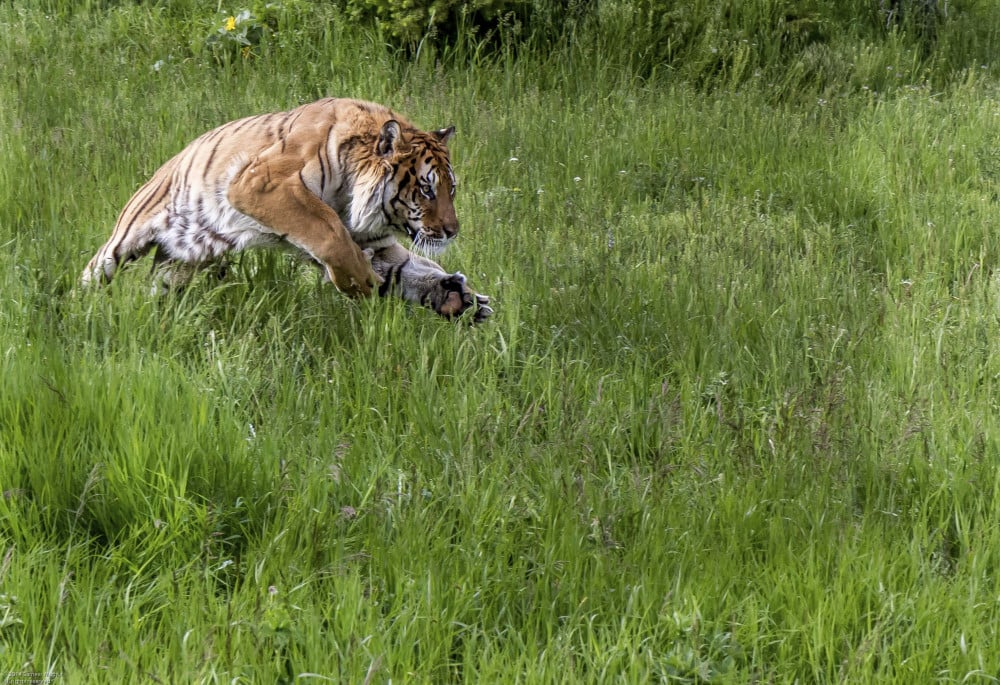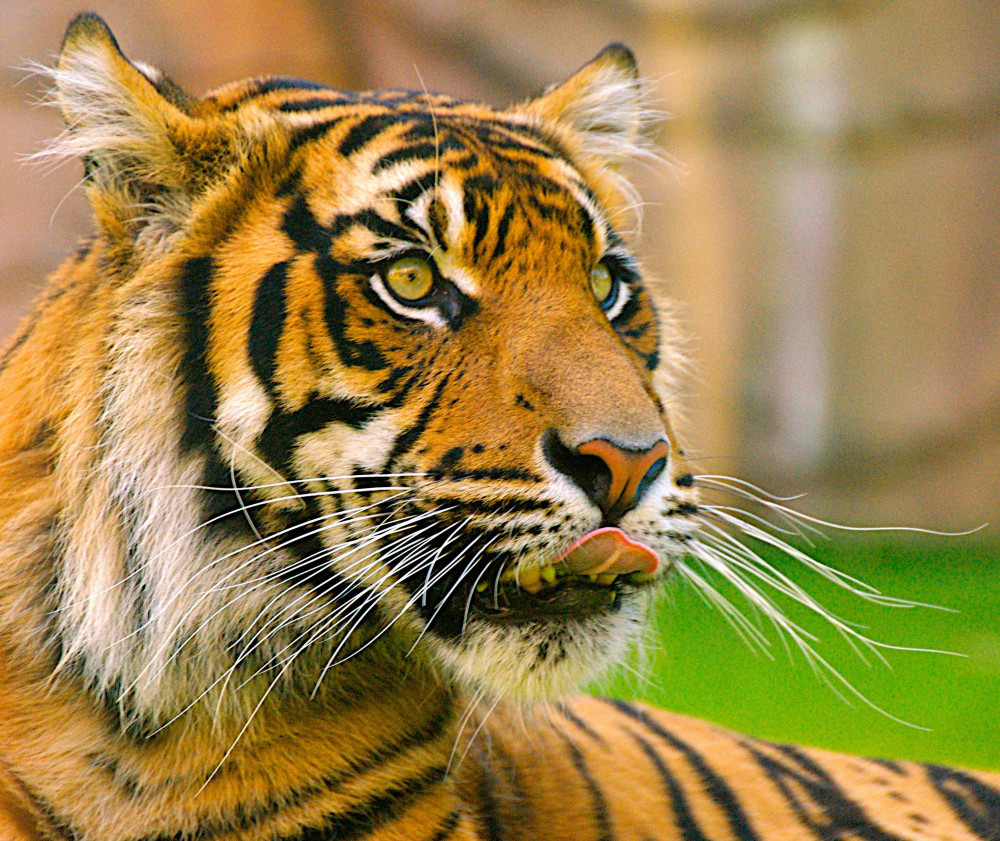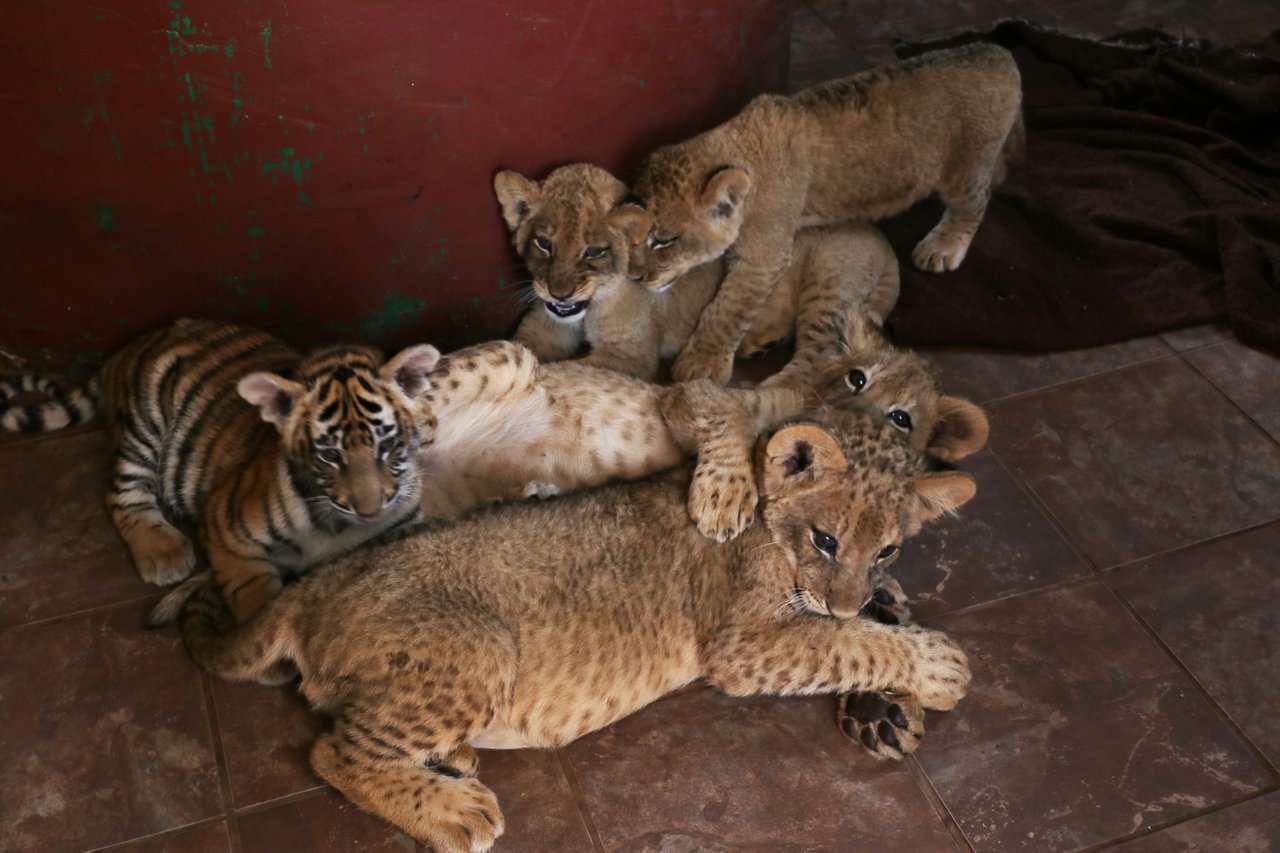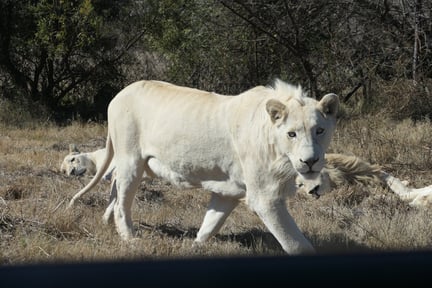
Share these tiger facts to educate others on the wild beauty of the tiger species and the unimaginable cruelty tigers in captivity face.
Found across the Asian continent, tigers are one of the most beautiful and powerful of the big cats. Read on for 14 facts about tigers in the wild and in captivity, and discover how you can help end captive tiger abuse.
1. Tigers are the largest member of the cat family, or Felidae.
While their size varies between species, the Siberian tiger is the largest. Adults can be up to three metres long and weigh up to 300 kilograms (that’s equal to almost a dozen ten-year-old children!).
2. Are tigers bigger than lions?
A tiger’s size is rivalled only by that of lions, which are almost as big. A full-grown male lion is almost a metre shorter and weighs 70 kilograms less than a male Bengal tiger, growing up to 2.1 metres long and weighing around 230 kilograms.
3. Tiger types
There are six remaining subspecies of tigers, including the Indo-Chinese, Bengal, Amur (Siberian), Sumatran, South China, and Malayan tigers. All are classed as endangered by the IUCN with only around 4,500 tigers estimated to be left in the wild, the majority of which are Bengal tigers.

A wild tiger leaping out of the grass. Credit: iStock. by Getty Images
4. Where tigers roam
Tigers have adapted to live in a number of different habitats, including grasslands and rainforests. Their natural range extends across the Asian continent, from Russia to North Korea and China, to Southeast Asia and the Indonesian island of Sumatra.
While this may sound like a large area, they only occupy around 5% of their original range. This is particularly problematic as these large animals need large territories to survive, roaming up to 32 kilometres in a night of hunting.
5. What tigers eat
Tigers are carnivores and excellent hunters. They can run as fast as 45kmph and have powerful jaws that can exert nearly 500 kilograms of force to catch their prey. They typically hunt large animals, including buffalo, wild pigs, antelope, sambar deer, wild boar, serows, bantengs, and young gaurs.
However, if the prey is scarce, they will also eat smaller animals like porcupines, muntjacs, monkeys, and hog badgers.
6. Tigers like to swim
Since cats have a reputation for disliking water, one of the most interesting facts about tigers is that they like to swim! In fact, they are very strong swimmers thanks to their large webbed paws and muscular bodies. Some tigers have been recorded swimming up to 29 kilometres across rivers.
Their unexpected love of water may be explained by the fact that tigers have evolved largely in the temperate climate of eastern Asia and don’t enjoy heat as much as other members of the cat family.

A captive Sumatran tiger in an Australian zoo.
7. A tiger mother knows best
Although some tendencies are instinctive, much of a tiger’s skill in hunting prey is taught to them by their mother. For the first two months of her cubs’ lives, a mother tiger keeps them in a den and rarely leaves them as they depend on her milk. She will then spend the following 22 months passing on all essential survival skills.
This is one reason why captive tigers suffer so much in entertainment venues, where newborn cubs and their mothers are often separated immediately after the cubs’ birth. Instead of being nurtured by their mothers, these cubs are subjected to relentless feeding and petting to grow accustomed to tourists.
This unnatural rearing disrupts their sleep cycle, puts them at risk of injury, and causes great stress. In later life, these tigers are also highly susceptible to malnourishment, emaciation, or obesity — and the wide range of illnesses that accompany these health disorders.
8. Tigers are solitary creatures.
In the wild, adults only interact to mate or to defend their territory, which can extend over 60 miles. This tiger fact emphasises the terrible conditions of China’s big cat facilities, which resemble factory farms.
In such facilities, tigers are kept in rows of small, barren cages measuring approximately 4x7 metres with hundreds of other tigers. Such unnatural confinement can cause the big cats to display abnormal behaviour, such as pacing back and forth along the same path and biting their own limbs or tails.
9. Are tigers endangered?
Tigers are an endangered species. Due to an increase in hunting, poaching, habitat loss, and heightened climate change during the 20th century, over 95% of the world’s wild tiger population has been lost. Just 100 years ago, there were 100,000 tigers living all over Asia.
Today, there are less than 5,000 left in the wild. Populations have disappeared completely from Vietnam, Cambodia, and Lao PDR since the turn of this century.
At this point, there are more tigers in captivity than in the wild.

A tourist takes a selfie at SriRacha Tiger Zoo now renamed Tiger Topia with concrete-floored, largely barren areas.
10. Suffering for selfies
Approximately 12,000 tigers are kept in cruel captive captions worldwide and are constant victims of irresponsible tourism. Their suffering has only increased as the demand for selfies and photo-sharing on social media has grown. In these facilities, tourists are allowed to sit with all types of tigers, from small cubs to full-grown adults, exposing these animals to unfamiliar people and loud, stressful environments.
To make the animals compliant and sit for photos, they are trained using abusive, punishment-based techniques and are often kept chained to a platform where they can’t perform natural behaviours. Once a tiger is no longer compliant, it is replaced with a younger, more controllable one — and the terrible cycle continues.
To make matters worse, tigers that are kept in such entertainment facilities are often inbred, which can lead to birth defects and health issues, meaning the animal lives in constant suffering.
11. Can tigers be domesticated?
Every day, thousands of wild animals are captured or born into captivity just to become pets. Tigers are no exception — despite the fact that they are not domesticated cats and should never be kept as pets. Our houses are not suitable homes for wild animals like tigers.
The techniques used to attempt to domesticate tigers are also cruel and unnatural. Such strategies include declawing the animal — a painful procedure that involves amputating the top of a tiger’s toes — and defanging the animal — the removal of the canine teeth.
Both affect the health and quality of life of tigers who can no longer walk naturally or eat meat on the bone, causing arthritis, tooth decay, and calcium deficiencies.
Learn more about how wild animals suffer in the exotic pet trade.
12. Farmed for traditional medicine
Outside of the tourism and animal entertainment industry, many tigers live in captivity due to the demand for big cat farming in traditional medicine. This is despite the international trade of tigers and tiger products being illegal since 1975 and a severe lack of scientific evidence that tiger parts are an effective medicine and herbal alternative.
Whether they are poached from their families in the wild at a young age or are unnaturally bred in sterile facilities, sadly these tigers’ fates all end in suffering and death. Between 2000 and mid-2022, at least 3,377 tiger parts were seized globally, including both live and dead tigers, as well as tiger skin, bones, claws, and teeth. These were being traded for use in medicinal tonics and as exotic luxury products.

These are cubs that have grown too big for the visitor petting experiences. They are likely to become targets for canned hunting, with their bones then being used in traditional medicine.
13. Tiger breeding breeds suffering
There are nearly three times more tigers in captivity than in the wild — and that number is steadily increasing due to questionable speed-breeding methods. Tiger cubs are cruelly taken away from their mothers at an early age, artificially forcing the mother to ovulate sooner, so she can breed again and produce more cubs.
And don’t be fooled into thinking that breeding tigers in captivity has conservation value. It’s quite the opposite! These tigers are bred for the wildlife entertainment and traditional medicine industries only. These bred tigers would never be able to return to the wild because they have never learned the skills needed to survive.
What’s worse, breeding tigers actually harms wild populations as it supports and intensifies the illegal trade in tiger products, increasing the market value of tigers, and creating an incentive for poachers to take them from the wild.
Tigers need your help
Protecting tigers is an urgent and critical task. Together we can take steps to ensure that tigers continue to thrive in the wild for generations to come.
Practice Responsible Tourism:
Choose ethical wildlife tourism options. Avoid attractions that exploit tigers for entertainment, such as circuses, petting zoos, and facilities that offer tiger cub interactions.
Boycott companies profiting from animal exploitation
Money talks. Companies like GetYourGuide are still profiting from wild animal entertainment by selling these attractions. By boycotting unethical travel companies you can drive them to adopt animal welfare policys.
Advocate for Policy Changes:
Lobby for stronger wildlife protection laws and policies at local, national, and international levels. Sign up to our newsletter and join our calls to engage with policymakers to ensure that tiger conservation is a priority.
Raise awareness
Educate others about the plight of tigers through sharing this blog, joining us on social media and taking part in community events. Highlight the importance of tiger conservation and the threats they face.
Big cat Blogs
-

Protecting South African Lions
Blog
South Africa’s government outlined mandatory exit options for the captive lion industry, discover the crucial steps needed to...
-

Endangered Lions & Tigers Used in Chinese Medicine
Blog
There’s a roaring illegal trade in endangered big cats killed for traditional Chinese medicine, and it’s clawing its...
-

16 fascinating jaguar facts — learn more about the...
Blog
Big cats are some of the most captivating wild animals. Elusive, powerful, and graceful. Lions and tigers are...



